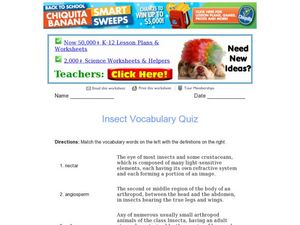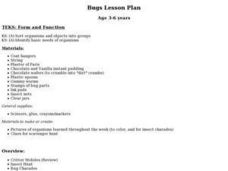Curated OER
Quiz on Insect Anatomy
For this insect anatomy quiz worksheet, students complete an on-line quiz, clicking on question and answer cards to complete and scoring 1 point per correct answer.
Curated OER
Our Forest is Changing
Young scholars read a story and solve a problem about an unhealthy population of trees. In this forest lesson students study tree disease and then research it online and present what they found.
Curated OER
Crickets Guided Discovery
Sixth graders investigate insect anatomy by analyzing a live cricket. In this insect science lesson, 6th graders discuss their knowledge of insects and describe their characteristics from memory. Students observe live crickets in class...
Curated OER
Taking a Micro Hike
Students investigate organisms by searching soil on their school ground. In this insect life lesson, students utilize field guides to help identify the organisms found in a rotting log on their campus. Students photograph any insects...
Curated OER
Body Parts of a Butterfly
Students identify the seven major parts of a butterfly. In this butterfly anatomy instructional activity, students explore three dimensional models of butterflies and discuss the anatomy. Students view a PowerPoint for the anatomical...
Curated OER
Label the Parts of an Insect
In this insect learning exercise, students label the parts of an insect on the lines drawn to each part. Students label 8 parts of an insect.
Curated OER
The Insect world
Students read about insects in pairs and answer questions based on their reading. In this insect lesson, students understand the parts of an insect and complete a worksheet. Students complete a list of insects letters a-z.
Curated OER
Do The Research! Insects
In this insects worksheet, learners research facts about the insect world. Students answer 3 short essay questions about insects.
Curated OER
Insect Vocabulary Quiz
In this insect vocabulary worksheet, students draw lines to match ten words pertaining to insect anatomy to their definitions.
Curated OER
Insect Wordsearch
In this insect instructional activity, students look for words that deal with insects in a wordsearch. Students look for 36 words and circle them once they are found.
Curated OER
Megabeasts
In this biology worksheet, students use their mathematical skills to create a three dimensional scale model of an ancient insect. They draw a diagram of their insect and label it with as much information as possible.
Curated OER
Butterfly Report
In this biology worksheet, students draw or trace an accurate picture of a butterfly. Then they complete the information related to their butterfly's classification and list the habitats where they are likely to be found. Students also...
Curated OER
Insect Challenge Project
In this biology worksheet, students identify insects by their name and write it in the correct box on the sheet. Then they catch insects with nets and bring them in to identify. Students also earn points for the number of insects caught...
Curated OER
Insect or Spider?
Students compare and contrast the difference between insects and spiders. After a brief class discussion, students complete an activity matching the body parts of an insect and the body parts of a spider. Worksheet with answer key is...
Curated OER
Insect Models
Students explore insects and have many opportunities to discuss, reflect, and record their explorations individually and in groups. They then make models of the insects as outlined in the instructional activity.
Curated OER
The Insect Files
Students are provided with a physical description of the insect, in words and graphics, including body parts, special adaptations, color, and so on. They explore and report on all four elements of an insect's habitat: food, water,...
Curated OER
Insects
Learners study the characteristics and basic needs of insects. They compare and describe similarities among insects. They examine the body structure, covering, and movement of insects and also, examine insect life cycles in this unit of...
Curated OER
Totally Termites
Young scholars explore the world of termites, their adaptations, and anatomy. They examine the property risks of termites and how pest control professionals manage termite problems.
Curated OER
Bugs Lesson Plan
Students complete a unit of lessons on insects. They participate in a bug hunt, construct paper flowers, discuss pollination, create bug paperweights and insect mobiles, play bug charades, and participate in a bug scavenger hunt.
Curated OER
"Ladybugs and Grasshoppers"
Students paricipate in number of activities related to ladybugs and grasshoppers.
Curated OER
Adopt-An-Insect
In this biology worksheet, middle schoolers locate examples of various types of insects listed in the chart and receive a point value for each according to its significance. Then they identify body parts and habitat for each item.
Curated OER
Adopt-An-Insect Bingo
In this biology activity, students select twenty-five terms relating to insects to complete their bingo card as listed on the sheet. Then they match each name or family with its correct description.
Curated OER
Minibeasts: What Sort is It?
In this insect related worksheet, students research and describe a variety of insects to see if they have several legs or a large foot. Students then decide what type of insects they are dealing with.

























